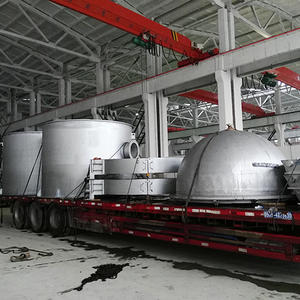Rotary refining furnace is also called rotary anode furnace. It is mainly used for the refining of liquid blister copper. The operation cycle is generally divided into four stages: feeding, oxidation, reduction, and casting. The product is used for electrolysis of anode copper. Rotary refining furnaces are mainly used in large or very large copper smelters.

The rotary furnace is a fire refining equipment developed in the late 1950s. It is a cylindrical furnace body, equipped with 2~4 air ducts, a furnace mouth and a copper outlet on the furnace body, which can be rotated 360°. Rotate the furnace body to bury the tuyere under the liquid surface for oxidation and reduction operations. The rotary furnace body can be used for feeding, slag discharge and copper discharge, which is easy and flexible to operate.
Rotary kiln has the following advantages:
1) The structure of the furnace body is simple, and the degree of mechanization and automation is high.
2) The capacity of the furnace varies from 100t to 500t, with large processing capacity, good technical and economic indicators, and high labor productivity.
3) Operations such as inserting air pipes and removing slag are canceled, and the consumption of auxiliary materials is reduced.
4) The airtightness of the rotary furnace is good, the heat dissipation loss of the furnace body is small, the fuel consumption is low, the smoke leakage is small, and the environmental sanitation is good.
The difference between rotary refining furnace and stationary refining furnace is that there is no fixed molten pool (slag) line. The erosion of slag and the erosion of molten metal almost involve more than 2/3 of the inner surface of the furnace; The body and the steel shell of the furnace body must be in close contact, and the friction between the masonry and the steel shell must be increased to overcome the rotational torque to maintain the stability of the body. Therefore, under the condition that the surface temperature of the furnace shell allows, the thickness of the masonry should be reduced as much as possible.
 English
English  Español
Español  Português
Português  русский
русский  français
français  日本語
日本語  Deutsch
Deutsch  Tiếng Việt
Tiếng Việt  Italiano
Italiano  Nederlands
Nederlands  ไทย
ไทย  Polski
Polski  한국어
한국어  Svenska
Svenska  Malay
Malay  বাংলা
বাংলা  हिन्दी
हिन्दी  Pilipino
Pilipino  Türk
Türk  عربى
عربى  Indonesia
Indonesia  norsk
norsk  čeština
čeština  Українська
Українська  Javanese
Javanese  فارسی
فارسی  తెలుగు
తెలుగు  Burmese
Burmese  български
български  Latine
Latine  Azərbaycan
Azərbaycan  Српски
Српски  Esperanto
Esperanto  Afrikaans
Afrikaans  Català
Català  Cymraeg
Cymraeg  Беларус
Беларус  Hrvatski
Hrvatski  Kreyòl ayisyen
Kreyòl ayisyen  Shqiptar
Shqiptar  Bosanski
Bosanski  Кыргыз тили
Кыргыз тили  ಕನ್ನಡ
ಕನ್ನಡ  IsiXhosa
IsiXhosa  Chichewa
Chichewa  Somali
Somali  O'zbek
O'zbek  հայերեն
հայերեն  Sundanese
Sundanese  Malagasy
Malagasy 






